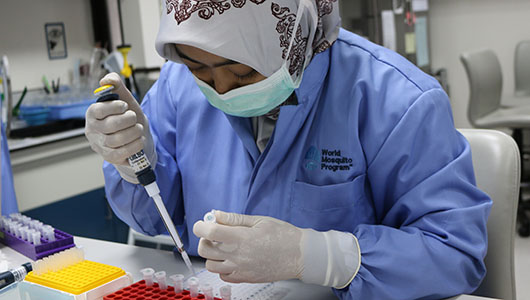Cases of dengue fever have fallen 77% with the Wolbachia method
31/08/2020
Guilherme Costa (WMP Brasil)
A study by the World Mosquito Program (WMP), from the University of Monash, in Australia, in a partnership with the Tahija Foundation and the University of Gadjah Mada, in Indonesia, points to a reduction of 77% in the incidence of cases of dengue fever, virologically confirmed, in the areas where Aedes aegypti with Wolbachia were released, in Yogyakarta, Indonesia, when compared with areas that did not receive the method. This is the first gold standard test to show the capacity of reducing cases of dengue fever using Wolbachia method in the Aedes aegypti. In Brazil, the initiative is led by Fiocruz and already has preliminary data showing a reduction in cases of chikungunya.

The study used the negative test method to analyze and measure the effectiveness of Wolbachia (strain WMel) in reducing the incidence of confirmed cases of dengue over a period of 27 months (photo: World Mosquito Program)
The randomized controlled trial (RCT) “Applying Wolbachia to Eliminate Dengue (AWED)” lasted three years and was carried out in an area inhabited by about 321,000 people. Twelve of 24 areas of sizes similar to that of Yogyakarta were chosen randomly to receive the WMP mosquitos with Wolbachia, together with the routine dengue control measures in the municipality. The twelve remaining continue to receive only the dengue control measures.
The trial involved 8,144 participants between 3 and 45 years old, who went to one of the 18 primary healthcare clinics with non-specific acute fever lasting from one to four days. The study employed the negative test method to analyze and measure the efficacy of Wolbachia (WMel strain) in reducing the incidence of confirmed dengue cases in a period of 27 months. Two years after the releases were concluded, the frequency of Wolbachia is still high in the populations of Aedes aegypti mosquitos in the 12 areas of intervention. The implementation of the Wolbachia method was well accepted by the community and no safety concerns were reported.
This study marks a decade of laboratory and field research, beginning in Australia and then expanding to 11 countries where dengue fever is endemic - Brazil included. The WMP global director, Scott O’Neill, states that this was the result the WMP scientists were expecting. “We have evidence that our method is safe, sustainable, and reduces the incidence of dengue fever. We can now expand this intervention to several cities worldwide”, he says.
Katie Anders, WMP’s director of impact assessment, highlights that “this is the first study that shows impact on the incidence of the disease. The result of the trial is consistent with our findings in previous non-randomized studies in Yogyakarta and in northern Queensland, and with epidemiological modeling predictions of a substantial reduction in the dengue fever load after implementing the Wolbachia Method.”
The independent statistician of the study, Nicholas Jewell, a professor of Biostatistics and Epidemiology at the London School of Hygiene and Tropical Medicine, and also a professor at the University of California in Berkeley, says that “the results are convincing. This is doubly exciting, as the design of the trial used in Indonesia provides a model that can be followed by other cities willing to make health interventions”.
Details of the results will be presented in November, at an academic convention, and will be published in a scientific journal. Further information can be found here.
Wolbachia Method in Brazil
In Brazil, the Wolbachia Method is led by Fiocruz, in a partnership with the Ministry of Health and with the support of local governments. The actions were kick-started in Rio de Janeiro and Niterói, in an area with 1.3 million inhabitants. In Niterói, preliminary data already point to a reduction of 75% of chikungunya cases in the areas that received the Aedes aegypti with Wolbachia, when compared with areas that did not.
The project is currently being expanded to Campo Grande, Petrolina (in the state of Pernambuco) and Belo Horizonte (capital of the state of Minas Gerais). In Belo Horizonte, another clinical trial, similar to the one led by WMP in Indonesia, will also be carried out. The city will be the first in the Americas to follow cases of dengue fever, zika and chikungunya by means of a randomized controlled trial (RCT), in conjunction with the Wolbachia Method.
In the first phase, some neighborhoods will receive the Aedes aegypti with Wolbachia, while others will receive the mosquitos after the study is validated and approved by the Ministry of Health. The neighborhoods that will receive the Wolbachia Method will be drawn randomly, a methodology proposed by the RCT.
Sixty children between 6 and 11 years old, from the 1st to the 3rd year of school, enrolled in public municipal schools of Belo Horizonte, were selected and will be invited to participate in the project. With the authorization of their tutors and with the necessary consent of the children themselves, samples of their blood will be collected to evaluate whether they have had previous contact with the dengue, zika or chikungunya viruses.
This study, called Projeto Evita Dengue (Avoid Dengue Project), is a collaboration with the implementation of the Wolbachia Method by WMP Brasil/Fiocruz, in conjunction with the City Government of Belo Horizonte. This is a scientific collaboration between the Federal University of Minas Gerais (UFMG) and the University of Emory, Yale University, and the University of Florida. The study is funded by the National Institute of Allergies and Infectious Diseases (NIAID/NIH), in the USA.
Prior to the RCT, a pilot of the WMP Brasil operation will be conducted in Belo Horizonte, in three areas involved in the Venda Nova Regional (Copacabana, Jardim Leblon and Piratininga health centers). The mosquitos with Wolbachia are expected to be released before the year is over.
More information on the Wolbachia Method is available here.




